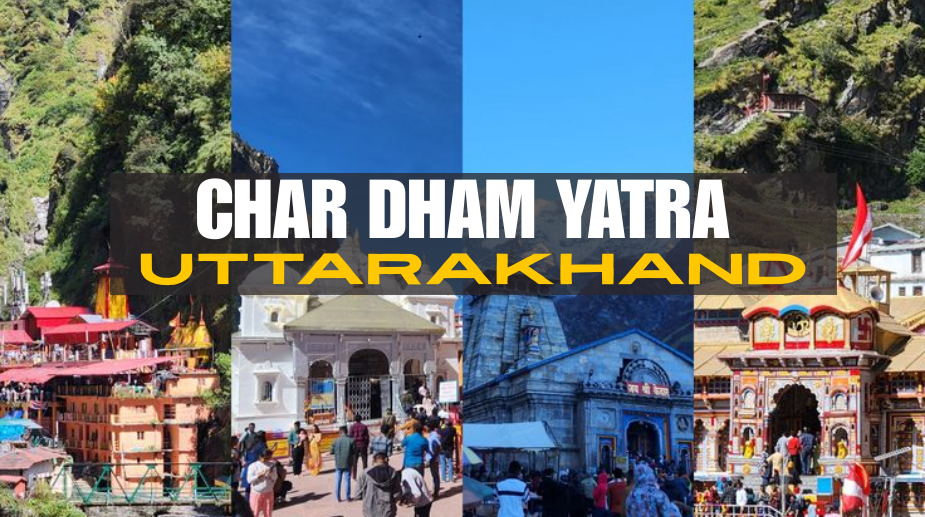
Discover the best time to visit, travel tips, and essential details for a spiritually fulfilling journey in the Himalayas. Plan your Char Dham Yatra 2025 with our complete guide to Yamunotri, Gangotri, Kedarnath, and Badrinath.
Char Dham of Uttarakhand
The Char Dham Yatra is much more than just a pilgrimage—it’s a spiritual journey that touches the heart and soul. Every year, thousands of devotees set out to visit the four sacred temples of Yamunotri, Gangotri, Kedarnath, and Badrinath, nestled high in the serene Himalayas of Uttarakhand.
For many, this yatra is a way to seek blessings, inner peace, and a deeper connection with the divine. But the Char Dham Yatra is not only about faith—it’s also about experiencing breathtaking mountains, flowing rivers, and the unmatched beauty of nature. Walking these ancient paths, surrounded by towering peaks and sacred rivers, gives every pilgrim a feeling of peace and renewal that stays with them long after the journey is over.
If you are looking for journeys filled with wonder and challenges, here is a carefully chosen list of 10 top trekking destinations—each a unique experience in nature.
Yamunotri Dham: The Sacred Source of the Yamuna
Within the Garhwal Himalayas, at 3,293 metres, Yamunotri emerges as the first stop of the Char Dham Yatra. This shrine, consecrated to Goddess Yamuna, marks the genesis of the river that Hindus revere as a celestial lifeline. Legend narrates her as the radiant daughter of Surya, the sun deity, and sibling to Yama, the sovereign of mortality.
Pilgrims bathe in her crystalline waters to shield themselves from premature death and summon vitality. Two sacred marvels define Yamunotri—Surya Kund, a scalding spring where rice and potatoes are cooked in cloth bundles to become blessed prasad, and Divya Shila, the venerated rock worshipped before stepping into the temple.
Reaching Yamunotri requires a six-kilometre ascent from Janki Chatti, a trail adorned with plunging cascades, whispering forests, and mountain rivulets. The temple awakens each year on Akshaya Tritiya in May and slumbers by Diwali. The ideal pilgrim months are May–June and September–October, when nature harmonises with devotion.

Gangotri Dham: The Sacred Source of the Ganga
At 3,100 metres, Gangotri rests amid the Garhwal Himalayas, enshrined to Goddess Ganga. It is here that the holiest river of India is venerated. The temple, erected in the 18th century by General Amar Singh Thapa, radiates an aura of purity. Devotees regard a sojourn here as a cleansing of sins and a step closer to moksha.
The true womb of the Ganga lies farther ahead—the Gaumukh Glacier, 19 kilometres beyond, reachable only by a trek. Pilgrims immerse themselves in the Bhagirathi River, coursing beside the temple, believing its waters wash away all taints. Surrounding jewels include Bhojbasa, Tapovan, and the ethereal Harsil Valley. The best months mirror Yamunotri—May to June and September to October. Gangotri is both a sanctum and a tranquil refuge, where myth entwines with Himalayan serenity.

Kedarnath Dham: The Abode of Lord Shiva
Kedarnath, revered as one of the twelve Jyotirlingas, exudes unmatched sanctity. At 3,583 metres in Rudraprayag, it reclines amidst towering, snow-veiled summits, its aura steeped in divine gravitas. Ancient lore ties its birth to the Pandavas, who, seeking absolution post-Kurukshetra, raised this shrine, later consecrated anew by Adi Shankaracharya in the 8th century.
The trek to Kedarnath extends 16 kilometres from Gaurikund, though ponies, palanquins, and even helicopters now aid the less able. The temple opens in May and closes by late October, with the deity transferred to Ukhimath for winter worship. Close by, Vasuki Tal, Chorabari Tal, and Triyuginarayan Temple deepen the sacred aura. Kedarnath is not just a shrine but a crucible where faith and Himalayan wilderness forge a spiritual resonance unmatched elsewhere.

Badrinath Dham: The Land of Lord Vishnu
Seated at 3,133 metres in Chamoli, Badrinath is perhaps the most illustrious of the four. Dedicated to Lord Vishnu, it belongs both to the pan-Indian Char Dham and Uttarakhand’s Chota Char Dham. Adi Shankaracharya revived its sanctity in the 8th century, and since then it has been the beating heart of Vaishnavite devotion.
Legends whisper that Lord Vishnu meditated here while Goddess Lakshmi, in the form of a Badri tree, shielded him from the Himalayan frost. The temple, with its vivid façade and intricate design, stands proudly beside the Alaknanda River. Pilgrim season stretches from May to November. Nearby wonders—Mana, India’s last village; Tapt Kund, a geothermal marvel; Vasudhara Falls; and the enchanting Valley of Flowers—enrich the pilgrimage with natural splendour.

Route & Travel Options
- The traditional path flows: Yamunotri → Gangotri → Kedarnath → Badrinath.
- Pilgrims embark from Haridwar, Rishikesh, or Dehradun, with taxis and buses aplenty.
- Helicopter services offer swifter passage for those constrained by time or strength.
Best Time to Visit
The temples awaken in April/May and rest by October/November. The most propitious months are May–June and September–October, bypassing the monsoons that cloak the Himalayas in perilous landslides.
Essential Counsel for Pilgrims
- Adapt steadily to resist altitude sickness.
- Carry layered clothing, rain gear, medicines, and firm footwear.
- Secure lodgings and travel ahead of peak tide.
- Honour local traditions and safeguard the sanctity of both temples and landscapes.
Spiritual Significance
This pilgrimage transcends physical movement; it is a metamorphosis of the soul. Amid rivers born of myth, snow-brushed summits, and sanctuaries carved from devotion, the Char Dham Yatra awakens the spirit and reshapes the inner being.
Conclusion
The Char Dham Yatra of Uttarakhand is not merely an expedition but a sanctified voyage where piety and wilderness intermingle. To those who tread its path with reverence, it gifts more than breathtaking scenery—it bestows peace, fulfilment, and an unspoken connection with the eternal. With preparation and faith, this journey etches itself upon one’s soul as a transformative pilgrimage of a lifetime.
FAQs
Q1. Why is the Char Dham Yatra important?
It is believed to cleanse sins, help achieve spiritual liberation (moksha), and allow devotees to receive blessings from four major Hindu deities by visiting their sacred Himalayan shrines.
Q2. How many days are required for the Char Dham Yatra?
The Char Dham Yatra typically requires about 10 to 12 days to complete by road. Helicopter packages can reduce the duration to around 5 to 6 days.
Q3. How to do Char Dham Yatra registration?
To register for the Char Dham Yatra 2025, pilgrims can register online via the official Uttarakhand Char Dham Yatra portal by filling in personal details, ID proof, and preferred dates, after which a QR code-based e-pass is issued.
Q4. How much does the Char Dham Yatra cost?
The cost of the Char Dham Yatra in 2025 varies widely depending on the package and mode of travel. Land tour packages start around ₹25,000 per person, while helicopter packages can cost around ₹1.3 to ₹2 lakh per person.
Q5. When does the Char Dham Yatra start in 2025?
The Char Dham Yatra 2025 starts on April 30 for Yamunotri and Gangotri, May 2 for Kedarnath, and May 4 for Badrinath.
Q6. Where is the Char Dham Yatra?
Char Dham Yatra is located in the Garhwal region of Uttarakhand, in the Indian Himalayas.




Leave a Reply